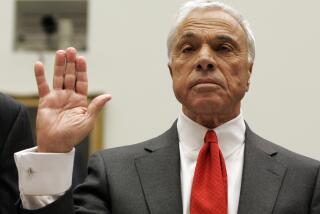Problems on 3 Fronts : New President Struggling to Right Valley Federal
The problems facing Valley Federal Savings & Loan Assn. in Van Nuys would make a splendid textbook case in problem solving for MBA students: What to do when an S&L; is under attack as a takeover candidate, its profits are sinking and its stock price remains dismally low?
The man who has to square those problems with solutions is Dan E. Nelms, who in March was named president and chief executive of Valley Federal. Nelms, 42, is an ex-Marine, but he is not a Vince Lombardi type. His voice seldom changes tone, and he occasionally lapses into the bureaucratic. For example, â . . . It was difficult trying to prioritize the next item of business.â
No matter; Valley Federal has needed a leader since Donald C. Headlund resigned as president in late 1987. Afterward the thrift was run by a four-man âoffice of the chief executive,â which included Nelms, for 4 months. But Valley Federalâs board of directors decided Nelms was the man to lead them out of trouble.
Why Nelms? âWe were surrounded with items that needed attention by someone who had the ability to deal with those issues with a level head and not be emotionally enthralled in the business at hand,â he said.
His matter-of-fact prescription for change is to cut costs--the company has laid off 35 of its 1,000 employees in the past year--curb its mobile-home lending business that has been a plague on profits, and refocus on the companyâs bread-and-butter business, making home loans.
He has plenty of work ahead of him. When Nelms took over, Valley Federal, one of the biggest thrifts in the San Fernando Valley with $3.3 billion in assets, was headed toward a 68% plunge in first-quarter profit, after a 49% earnings drop for 1987âs fourth quarter. The S&L; faced a hostile, $112-million takeover bid from Citadel Holding Corp., the Glendale parent of Fidelity Federal Savings & Loan.
âI spent most of my weekends either in this office or buried under volumes of stuff I had to get through,â Nelms said.
Valley Federal ended the first half of this year with a $3.3-million loss, against a $13.1-million profit a year earlier. Nelms predicted that the thrift will show earnings for the second half of 1988.
His biggest problem is what to do with a Valley Federal subsidiary, All Valley Acceptance Corp. (AVAC), which makes loans to buyers of mobile homes and then sells those loans to investors.
Since the unit was started in 1983, Valley Federal has pumped nearly $50 million into AVAC but it has been losing money recently. In the first six months of this year, AVAC, which made many loans that later soured to borrowers in such distressed states as Texas and Colorado, lost $2.5 million, and Valley Federal expects it to show a loss for the year.
In its second-quarter report to the Securities and Exchange Commission, Valley Federal said unidentified parties that have looked into buying Valley Federal said they want AVAC jettisoned first. And any sale of AVAC âis likely to be at a substantial loss,â Valley Federal said.
Even so, Valley Federal will not sell AVAC for peanuts. Nelms said the thrift âcouldnât find a buyer at the right priceâ when it tried to sell the unit earlier this year, so Nelms is scaling back AVACâs business to save cash. âOur goal for 1989 is that they break even,â he said.
Merger Threat
Meanwhile, the immediate threat of a takeover from Citadel has stalled before federal regulators, so Nelms has won some time to put his plans into effect. But Nelms cannot rest easy. Citadel still favors a merger, and in the meantime Valley Federalâs stock price remains flat.
The stock, which reached as high as $22.25 a share amid Citadelâs bid, has since tumbled, closing at $13.25 in over-the-counter trading Monday, which is lower than Valley Federalâs $16.32 book value (its assets minus its liabilities). In other words, the stock market figures that Valley Federalâs performance is so mediocre that it does not award any value to the companyâs ongoing business.
To pique Wall Streetâs interest, Nelms will have to make major strides. Even before Valley Federalâs recent troubles, the thrift was not a standout performer. Its return on average assets--which measures an S&L;âs earnings against the assets at its disposal--has not exceeded 0.65% in the past five years, which is considerably less than the 1% or more return that is considered an excellent showing.
Home Loans
But Nelms is banking on Valley Federalâs basic business--making home loans and handling saversâ deposits--to turn the corner. He insists that Valley Federal remains a âstrong, healthy companyâ that should âmarch into 1989 with a clean slate.â He said special, one-time charges that contributed to the recent losses will be gone, and that profits are improving.
The special charges that helped lead to Valley Federalâs recent losses included the settlement of a lawsuit, costs related to the Citadel fight and an accounting change. But Valley Federalâs operations also are hurting.
The companyâs profit margin--the spread between how much interest it earns on loans and how much it has to pay depositors and others for the funds in the first place--plunged to 1.85% as of June 30, from 2.61% a year earlier. Valley Federal blames the slide on two factors: rising money-market rates and its big portfolio of adjustable-rate mortgages (ARMs).
Like other S&Ls;, Valley Federal recently has made home mortgages mostly with adjustable rates, which carry a low interest rate for six months or a year, after which the rate is increased to match market rates. But in recent months Valley Federal has had to pay higher interest rates to depositors as market rates have risen, squeezing Valley Federalâs profit margin until its ARM loan rates start increasing as well.
Low Rates
Because Valley Federal wrote an unusually large number of new-home loans last year, about $600 million, or 21%, of its $2.9 billion in loans outstanding remain at their low, introductory rates, Nelms said. But the rates on most of the loans are scheduled to start climbing in the second half of 1988, which âwill certainly have a substantial impact on our earnings,â he said.
Nelms, who grew up in Arkansas, has been in or around the banking world since age 21, when he got a job as a bill collector with a consumer finance company. Over the next few years, he was a mortgage loan agent, and he worked for a mortgage banking subsidiary of Anaheim Savings & Loan (now United California Savings Bank).
In 1974, he moved to Glendale to join Fidelity Federalâs secondary market operation, whereby the S&L; would make home mortgages and then sell them to investors. He was managing the operation in 1981 when he was hired by National Mortgage Investors, a Pasadena mortgage broker. He joined Valley Federal in 1983.
Nelms figures that with his portfolio of home mortgage rates adjusting up soon, and the other tidying he has done, âwe have turned the cornerâ toward showing a profit.
Board of Directors
In the meantime, Nelms need only look to his board of directors to be reminded that all of Valley Federal might someday again be on the selling block.
On the board is James J. Cotter, a partner of Hecco Ventures, an investment partnership that owns 9.9% of Valley Federal and has pushed for the thrift to be sold.
Cotter won election to the board in April, and he and other dissidents persuaded Valley Federal to set up a committee to find ways to enhance the value of the S&L;âs stock--which could include its sale. The committee has yet to reach any conclusions, however, and Cotter could not be reached for comment.
How does Nelms feel about Cotter in the board room? âAll the conversations are friendly,â he said, but added, âThereâs obviously some tension.â
More to Read
Inside the business of entertainment
The Wide Shot brings you news, analysis and insights on everything from streaming wars to production â and what it all means for the future.
You may occasionally receive promotional content from the Los Angeles Times.











